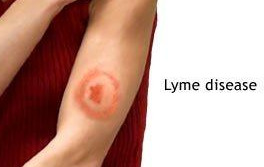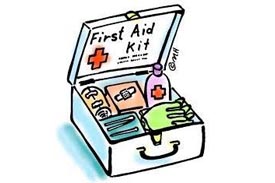Home Invasion: II, Lyme Disease
 A very serious invasion is ticks. For our rural lifestyle, way back in the bush, DEER TICKS have expanded their deadly reach along with the overpopulation of Whitetail Deer. This article is directed at why I, and others have contracted LYME DISEASE, how to prevent it, and a plethora of medical links.
A very serious invasion is ticks. For our rural lifestyle, way back in the bush, DEER TICKS have expanded their deadly reach along with the overpopulation of Whitetail Deer. This article is directed at why I, and others have contracted LYME DISEASE, how to prevent it, and a plethora of medical links.
The identification of the bacterial infection known as Lyme Disease stems from the first reporting back in the 1980’s in Lyme Connecticut. At that time it was a new strain and contained to a specific area. Today this tick born disease is up and down the east coast with density patterns in the New England area. Related ticks harboring this bacterial infection are also found on the West Coast. So far the reported infections in the Central United States are few-but like Plagues, they will expand.
I suspect that the shipping from other countries has imported this bacterium. Europe also has Lyme disease; hence my supposition it is growing like the Bubonic Plagues in Europe during the 14th century and through later years. The origin of this disease may stem from Africa, where many other diseases have emerged; the Ebola family being really scary.
Let us start with the fertile little field/house mouse. Deer Ticks, are the same as other ticks: They will seek a host to gain nourishment and repopulate. When the eggs and nits of the tick fall off the host, be it: Deer, horses, cattle, coyotes, dogs, cats etc, the ground litter will cover and protect the tiny creatures from the rigors of winter. They can be found under leaves where they remain protected in the organic warmth of nature to emerge in the warming spring.
Once warm weather starts, like it did this year of 2011; a very early warm spring indeed, the nits climb on the short growing grasses and as Mr. Mouse comes along, they attach, feed and grow; then drop off the mouse. Then the cycle of emergence to a full size Deer Tick comes to pass. The period at the end of the sentence, slightly doubled is the size of a Deer Tick in the adult stage. Dog ticks are much larger.
As an adult the Deer Tick can climb higher along with the growing vegetation and as larger animals brush against the grasses they spring and attach quickly to a new host. More feeding, more egg production, and the cycle starts over.
This year population of deer in the fields and woods who are constantly moving about offer more bodies than the occasional lesser animals including, yes, humans bustling about the flower bed and walks in the woods where beautiful trees who are bursting color.
Just this morning as I opened my back door I saw a doe adult deer walking past my barn- just an unconcerned Ho-Hum- walk. Last week when returning from town as we turned off onto our two-mile stretch of road we viewed and counted 39 deer grazing in the hayfields in a one-mile stretch. I can only wonder at the amount of deer at that time unobserved in the bushes.
I support deer hunting as many deer will just succumb to the tick’s bacterial infections and die a miserable death, alone in the forests, and in the mean time drop hundreds of ticks hither and yon for the mice. Actually it ought to be called a mouse tick, but the ever-moving deer population up and down the coastline and expanding into the interior of the states spreads the ticks. Time to get the old shooting iron off the fireplace mantel and prepare for a venison stew. Obviously the thorough cooking of the deer meat, making jerky, or otherwise “well done” is an imperative in reducing any bacterial infection.
Since hunters process their deer, the possibility of deer ticks is real. You might want to buy a 10 pack of HME™ Game Cleaning Gloves, item# K2X-207773 from http://www.sportsmansguide.com/net/Main.aspx? $11.69 for 10 pk. These are shoulder length.
Needless to say when processing your deer, be aware of the tiny Deer Ticks in the fur.
A local taxidermist commented recently that deer heads severed for mounting and kept in a freezer revealed upon removal- live ticks. Ticks do not die off in freezing weather. They will suffocate from melting snow packs however-but not all. This is nature’s way. Now that the climate is in a warming change we can expect more ticks.
To reduce ticks in your yard and garden it is the mice you need to kill off with traps and bait carefully, and safely placed. You can set these bait stations and traps outside as well as inside buildings. As far as deer goes, a boundary fence is important. My perimeter 5’ high fence and a dog keep them out, otherwise they will be right up to the windows.
Instead of chickens this year, perhaps Guinea fowl. Check out: www.dogbreedinfo.com. Type in search: Guinea fowl. They pick ticks.
I now suspect that my declining barn cat population may be due to the Deer Tick. However these are untouchable semi feral cats. My dogs are a different story. They can be treated to resist ticks. Since I am now in DEFCON 3 mode of tick prevention I checked with my Veterinarian in Christiansburg, Dr. Young. He stated that Frontline Plus was a better tick preventer than Advantage if you get the weight of the dog correctly recorded. One of our lap dogs is 22 lbs. And a tick was right on him, right where the flea and tick monthly applicator is applied. He needed to be upped to a 23-44 lb treatment.
For KIXX, my hairball sheep dog I have returned to the application of .05% SEVIN dust (do not mix Frontline Plus, etc with SEVEN dust – this can be toxic to your pet). This is also liberally dusted in his favorite haunts and beds. Both dogs are tick checked and combed each evening.
What repels ticks on people? DEET, an anti-bug repellent was perfected back in WWII, and even now it is the only successful anti-bug repellent known. There was some controversy about its safety, but it is still sold; the military grade is 33%. Lesser strengths can be had through AMAZON.com under the trade name of DEET.
I had mentioned some time back in a gardening article that wearing lace up boots with your pants tucked in was a step in the right direction. In ‘Nam we used to put dog flea collars around our boot tops but of course this was discontinued. I am going back to this method of additional self-protection in reducing ticks. Of course one is protected up to the waist. A long sleeve shirt is also indicated, buttoned up when in the bushes. I was reading about using sulfur dust, as common use in Mexico. My experience with sulfur dust is in the garden when cutting up potatoes for starts. I always get the dust on my clothes, and then my hands, and then my eyes. AGGGH! I think DEET is a better way to go.
I believe that I was exposed to the LYME TICK in my Man Cave bedroom. I spotted one tick, the tiniest little thing just scoot across the white hair on Kixx’s head. Of course I picked it and dropped it in a can of vinegar just for that purpose. I also discovered that the dog ticks, AKA: Brown ticks would drop off and crawl under throw rugs to hatch. A thorough vacuuming is necessary. I would see an advantage in bare wood floors, and more vacuuming, maybe SEVIN .05% dusting. Does anyone sell Kryptonite?
“Tick Checks” are important. One has to strip down, and the married partner checks for ticks. This is fun when you are younger. When you are old, your eyesight is far sighted and that tiny mole maybe a tick. Apparently that was my fate. I thought the tiny brown spot was a tiny itchy mole. A few days later I went down stairs and had a deep chill; my teeth chattered and my hands shook. I could not control this spasm. I though a hot shower would help. Then in the mirror I noticed a big saucer size red patch. Not a bulls-eye as is often an indication of a Deer Tick bacterial infection, just a big red circular patch. I then started with hot sweats and headaches. I might add that if you catch the tick and remove her within 18 or so hours the tick will not regurgitate into the bite inserting bacterium. At least that is the current view. They usually fill up and drop within 24 hours.
Of course this was on a Friday and the Doctor’s office would not be open until Monday. So I read up on Deer Ticks in my MERC Home Manual and other texts in the meantime. This is a good medical reference to have in your house.
It seems if I was on the predicable course except it was not a bull’s-eye, just a red patch. The small tick had long dropped off. Maybe I scratched it off.
Monday I was off to the physician’s office. He prescribed DOXYCYCLINE HYCLATE 100 for two weeks; two tablets a day, 12 hrs apart. In three days I felt better. The physician also ordered a lab blood report. This is interesting as the LYME TICK bacterial blood work is 50-50. Sometimes it will not indicate anything. Other times it will. Well I was loaded. That was a confirmation I will have to be monitored for my remaining years as the bacterium, as with several other tick bacteria, has cycles.
An important fact while taking the medication you cannot ingest dairy products with the medication.
The first cycle is the bite and immediate symptoms. Sometimes there are no symptoms. The second cycle is a back to normal state while the bacteria is growing inside the body waiting to emerge in the third cycle. This is the bad news as it may be several weeks, or even years, but the bacteria is growing in the body, becoming more difficult to get rid of. Expect EARLY LYME ARTHRITIS, and worse: early senile decline for one.
There are no herbs, or prayers, for this – only modern medication.
The following science links on Deer Ticks will be of great importance for the reader. I would add that the Goggle Images: type in: Lyme Ticks. This will chill you.
ID ticks: http://www.oes.org/html/how_2_identify_different_ticks.html
On Lyme Disease: http://www.rosenkilde.com/Lyme-Disease.html
CDC on Lyme Disease: <http://www.cdc.gov/lyme/
God Bless,
Old Timer,
COPYRIGHT: Back2theLand.com 2012. All rights reserved. Please pass this on to friends and neighbors.



